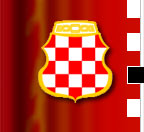|
The original
Bosnia, or "small land of Bosnia" (to horion Bosona)
was for the first time mentioned in the middle of the 10th
century in the work of Constantine Porfirogenet (De administrando
imperzo), as a part of Duke Caslav's Serbia, but however,
clearly separated from Serbia proper.46 The original Bosnia
was spread across the highlands around the upper stream of
the river Bosna. It was separated from the neighbouring regions
by a mountain range towards rivers Vrbas, Neretva and Drina.
In order to develop, Bosnia had to expand territorially from
its core.
As Vjekoslav
Klaic said, "from the very beginning, Bosnia stood between
Croat and Serb peoples", which meant that it was always
between two (Croat and Serb) dominating state and ethno-social
centers in the South-Slav lands. During the medieval times,
Bosnia expanded onto Croatian (mostly), as well as Serb lands
(at times).47
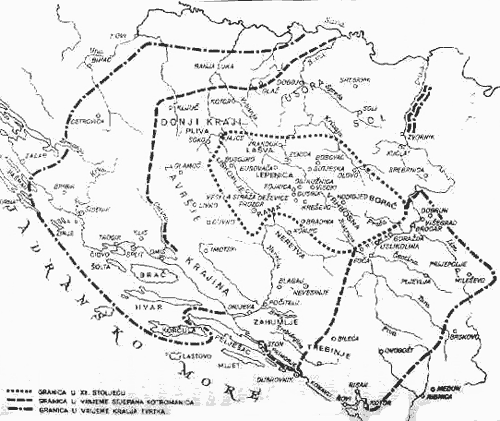
The
growth of Bosnia
(T. Macan "Povijest hrvatskog naroda")
In order
to explain the social complexity of medieval Bosnia, a historian
must take note of both directions of Bosnia's expansion, and
consequently, both the western and eastern influences on its
development.
The necessity for communication
The breakout
from the initial core ran parallel with the development of
an independent Bosnian state. Bosnia had expanded past the
midpoint of the river Drina, towards the Serb lands, perhaps
as early as during the reign of Ban Kulin (towards the end
of the 12th century), but definitely during the reign of Ban
Matej Ninoslav (mid 13th century). Crucial for Bosnian development
was its territorial drive towards west, south-west and further
south to the coast, especially toward the eastern Adriatic
coast, all these being Croatian regions. Further Bosnian territorial
drives in 13th and 14th centuries, the annexation of parts
of the Croatian kingdom (Donji Kraji and Zavrsje) had a twofold
effect. First, Bosnia now included significant parts of the
Croatian kingdom, and secondly, Bosnia was now in a close
geopolitical and economic relationship with the surrounding
Croatian lands.
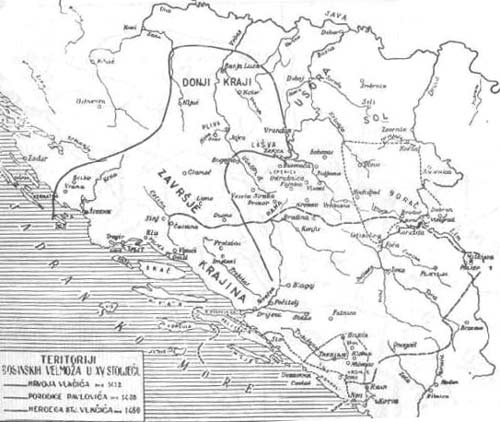
The
territories of Bosnian lords in the 15th century
(F. Sisic "Povijest Hrvata u vrijeme narodnih vladara")
Certainly,
Bosnia also absorbed some Serbian regions in the 14th century,
as King Tvrtko's Bosnia expanded towards east and south-east,
encompassing Upper Podrinje and Polimlje all the way down
to Dubrovnik and Kotor hinterland. As was mentioned before,
the surrounding and annexed Croatian regions were far more
important in Bosnia's development.
Bosnia's
territorial enlargement during the reign of king Stjepan II
Kotromanic and Tvrtko I was first and foremost directed at
the eastern Adriatic coast. Such large changes greatly influenced
the relations between Bosnia and the Croatian kingdom. A very
strong social current towards the belt of settlements from
Zadar to Dubrovnik meant that Bosnia developed strong economic,
folk and reflective ties with the Croatian domain. It can
be said that Bosnia had a specific role as a border zone,
connecting Croatia with the wider Balkan region.
Active
economic ties and trade between Bosnia and Croat coastal towns
can be observed from as early as reign of Ban Kulin all the
way up to the Turkish invasion. Beginning from the "friendship"
contract between Ban Kulin and Dubrovnik in 1189, through
to the sudden rise in trade that was due to the construction
of important landmarks of Split in 1592. Social communication
between the Croatian kingdom and Bosnia, first and foremost,
meant interaction of the peoples. Migrations, especially from
Bosnia towards the Adriatic coast and running the other way,
from Dalmatian towns into Bosnia - resulted in an exchange
of ideas and concepts (dualist heresy, language and art).
Bosnia's
unique social development was a legacy of eastern and western
influences. Influences eminating from the east were an initial
guide in development, but from the 12th century onwards, western
influences had become dominant. Heretic, dualist ideas from
the east were the main factor in the creation of a "Bosnian
church", the strongest factor in Bosnia's uniqueness,
It must also be said that from the outset, the western church
had a very strong influence in Bosnia. Indeed, even the heretic
"Bosnian church" was created within the jurisdiction
and the embrace of the western church. As of the 14th century,
an important factor in the spiritual and social development
of Bosnia was the activity of the Franciscan order. Bosnian
language and script was also a combination of western and
eastern influences. The initial glagolitic base had been supplemented
with the use of Cyrillic script, but with a Bosnian adaptation.
Morphologic simplicity, folk grammar, the "ikavica"
dialect and the visual differences mean that the Bosnian version
of Cyrillic was clearly different to the eastern version.
The two Cyrillic zones - eastern and western, did of course
have the same origin, but their spiritual use and role in
the society were quite different.

National consciousness
In extremely
rare available data on national consciousness during the late
medieval period of Bosnia, Bosnian orientation of the Slav
core is evident. However, it is necessary to point out two
things. First of all, that the name "Bosnjani" (Bosnenses)
is complex because it is applied as a designation on many
different levels (in one instance, for example, to distinguish
aristocracy from ordinary subjects), and secondly because
the name developed parallel with other processes. The development
of national consciousness in Bosnia can only be analysed in
light of social consequences of the events occurring around
that time. Such events were for example the extending of Bosnian
borders onto formerly Croatian and Serbian lands, and the
activity of Catholic and Orthodox churches on Bosnian territory.

"Srblin" and "Vlah"
Research
on ethno-social development of Bosnia runs into difficulties
even during the translation of Bosnian Cyrillic documents
from the 13th Century, especially in three documents attributed
to Ban Matej Ninoslav. In these, Matej Ninoslav uses the term
"Srblin" (Serb) for inhabitants of Bosnia and juxtaposes
it with "Vlah" (Vlach) for the inhabitants of Dubrovnik.50
These designations have been subject to many interpretations,
ranging from complete rejection to absolute acceptance.51
In order to explain this historical enigma, it is necessary
to analyze Cyrillic documents from the 12th and 13th Centuries.
The analysis
of these documents shows that the designation in question
("Srblin" vs "Vlah") did not originate
in medieval Bosnia, but rather in Serbia. The first instance
of these names being used was in the document of the Great
Duke of Raska (a predecessor to Serbia), Stefan, to Dubrovnik
written around 1215.52 Today, we recognize that particular
document was written by a Dubrovnik notary, Paskal, which
becomes even more crucial when we note that two out of three
of Matej Ninoslav's documents were also written by this particular
notary in 1240 and 1249.53 First of Matej Ninoslav's documents
was written before 1235 by notary Desoje, but this doesn't
affect the conclusion that the juxtaposition of the national
designation "Srblin" vs "Vlah" found its
way into Bosnian documents from Raska, through the complicity
of the Dubrovnik public office. Another fact that supports
the conclusion that names used in Ninoslav's documents did
not reflect the national composition of Bosnia in the first
half of the 13th Century, is the fact that Ban Kulin's document
sent to Dubrovnik in 1189 does not recognise the name "Srblin".
As a document older than Ninoslav's, it would be expected
that it would contain this designation, if it indeed was actually
used in Bosnia. Furthermore, it doesn't even use the term
"Vlah"54 when referring to the inhabitants of Dubrovnik.
The term "Vlah" when referring to an inhabitant
of Dubrovnik, is thus, definitely not of Bosnian origin, likewise
with the term "Srblin" for inhabitants of Bosnia.

Bosnia and Serbia
Such unusual
use of the terms "Srblin" and "Vlah" between
the Serbian, Bosnian and Dubrovnik public offices indicates
that it could only occur in Bosnia because it's ethno-social
order and a national name was still under development in the
first half of the 13th Century. National characteristics of
the Slavs in Bosnia had not clearly developed by this time.
The role of the Dubrovnik notary, Paskal, indicates that in
the minds of the people of Dubrovnik, Serbia's leading position
in the Slavic, continental hinterland had been a decisive
factor. During the reign of the great Duke Stefan Nemanja,
after the conquest of Duklja in 1183, Raska had occupied the
whole region surrounding Dubrovnik, including Zahumlje, Travunja
and Duklja. Such a mindset included data about the political
allegiances of Bosnia at the beginning of its written history
whereby according to Porfirogenet, "small land Bosnia"
in the middle of the 10th Century was a part of Serbia. Such
a territorial/political belief about the continental hinterland
of Pop Dukljanin (Grgur Barski) was prevalent two centuries
after.
In mid
12th Century, the chronicle Primorju (Maritima) from Duklja,
in which White and Red Croatia are separated, are contrasted
to Serbia or Zagorje (Surbia, Transmontana), composed of Bosnia
and Raska.55 With such a prevalent sentiment, it's not surprising
that even the Pope's decrees from late 12th and early 13th
Century, using the information coming out of Dubrovnik, mistakenly
identified Serbia with Bosnia (regnum Servillie, quod est
Bosna).56 At the time when those Papal decrees were written,
during the reigns of Ban Kulin and Ban Matej Ninoslav, Bosnia
was not a part of Serbia, but memories of Bosnia's initial
position vis a vis Serbia in the beginning of the 12th Century
still abounded, especially in the cities of Upper Dalmatia
(Bar, Dubrovnik). In accordance with such beliefs, and with
the activities of the Dubrovnik public office, terms "Srblin"
and "Vlah" had made their way into Bosnian public
documents. That means that the term "Srblin" in
Ninoslav's documents was not a reflection of the national
consciousness in Bosnia, but was rather a late result of political
influences of Serbia before the establishment of a Bosnian
state. That is why we cannot take those terms as being accurate
when describing the national consciousness of Bosnia in the
first half of the 13th Century. Quite the opposite then, they
are the proof of its lagging development in terms of national
sentiment. It needs to be reiterated that the equality "Srblin"
= an inhabitant of Bosnia appears in only three documents
of Ban Matej Ninoslav and there is no mention of it in any
of the later works and documents.

The extent of ethnic identification?
No Bosnian
documents from the late 13th and early 14th Century have survived.
Ethno-social occurrences from that time period thus stay outside
a historian's view, but at the time when Bosnia, under Ban
Stjepan II Kotromanic entered a phase of territorial expansion
and social growth, the concepts of national consciousness
became more complex and with new factors added to the mix.
The first item to be noted is the use of the Bosnian name
in the 14th and 15th Century. The name is used in Cyrillic
documents of medieval Bosnia, in Latin scripts about the "Bosnian
church" and the notaries of Dalmatian towns. But in each
of those three instances, the Bosnian name pertains to a different
group, every one of them is indicating a separate level of
national consciousness. What was the role and purpose of the
Bosnian name?
The Bosnian
name was first used in Cyrillic documents. In determining
the relationship with Dubrovnik, and the procedure for solving
arguments, Ban Stjepan II, in a document from 1322 uses the
terms "Dubrovcanin" (obviously, a citizen of Dubrovnik)
and "Bosnanin". That oldest authentic name for an
inhabitant of Bosnia occurs very rarely in documents of Bosnian
kings - but when it does, it is usually "dobri Bosnane"
("the good Bosnian"). After Bans Stjepan II and
Tvrtko I we encounter this term in some documents from the
15th Century (Tvrtko II, Stjepan Ostojic, Stjepan Tomas).57
Even this relatively rare mention of the name "dobri
Bosnane" is very important. First of all, the usage of
terms "Bosnjanin" vs "Dubrovcanin" in
the document of Ban Stjepan II in 1322 isn't a continuation
of the documents of Ban Matej Ninoslav, but rather builds
on Kulin's document from 1189. Kulin doesn't use the term
"Bosnjanin", but does use the term "Dubrovcani",
and not "Vlasi". Terms "Srblin" and "Vlah"
were only temporary, and as previously discussed, found their
way from Raska into the public office of Ban Matej Ninoslav,
and certainly had no base in the actual social and national
order of Bosnia, and that is why there is no trace of them
ever being mentioned again after the first half of the 13th
Century. Only the term "Bosnjanin" correctly reflected
the independence of Bosnia, and that is why it is used in
the documents from the 14th and 15th Century. But, to what
or whom did exactly these terms, "Bosnjanin" and
"dobri Bosnjani" refer to?
The term
"dobri Bosnjani" has a class designation. It refers
to aristocracy, and not an inhabitant of Bosnia, or a citizen
of the Bosnian state. In the latter part of medieval times,
Bosnia in 1377 became the Bosnian kingdom (Regnum Bosnae),
and the dominating orientation was an allegiance to the crown
and the state. The Bosnian state or "rusag Bosanski"
included all of the Bosnian aristocracy, ie. "dobri Bosnjani".

The Heretics
Alongside
the narrow definition of a Bosnian contained in the Cyrillic
documents, in Latin sources from the 14th and 15th Century
about medieval Bosnia, a more broad application of the Bosnian
name is used. Firstly in Latin scripts about the heretic "Bosnian
church". In a correspondence between Pope Grgur XI (?????)
and a Bosnian Franciscan Bartholomeus, where the Pope is answering
23 questions on the Church's stance towards the scismatics
and the heretics, the term "Bosnenses" (Bosnjani)
is used in the fourth question. In the twentieth question,
and the Pope's answer, the term "Bosnjanin" is used
as a synonym for a heretic or a non-believer (Bosnensis vel
infidelis). In the eighth question, that term is explained
as referring to "Heretic people from Bosnia".60
The Bosnian name in Latin scripts about the "Bosnian
church", thus has a clear meaning. "Bosnjani"
in Franciscan documents from 1373 are the members of the "Bosnian
church".61 The scope of that designation is evidently
wider than the term "dobri Bosnjani" from Cyrillic
documents, but even this broad designation did not refer to
all inhabitants of Bosnia, regardless of their class or religious
status.

The Franciscans
In
evaluating the role of the Franciscan order in medieval Bosnia,
the fact that the western church had an earlier presence in
Bosnia, a long time before the arrival of the Franciscans,
shouldn't be ignored. As was pointed out earlier, the heretical
"Bosnian church" itself grew out of the Bosnian
Catholic diocese.
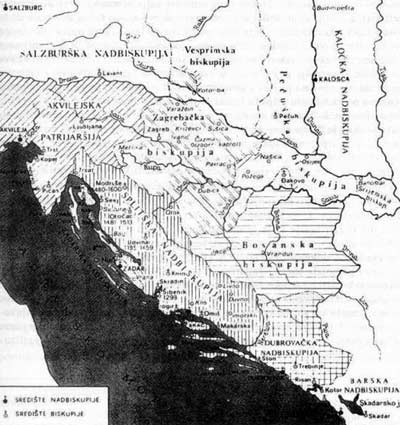
The
territorial oganisation of churches in Croatia and Bosnia
(N. Klaic "Povijest Hrvata u razvijenom srednjem vijeku")
As
the dualist heresy in the first half of the 13th Century gradually
developed into an independent "Bosnian church",
so grew the attention of the Catholic Church towards Bosnia,
beginning with the rejection of the Heretic principles by
Ban Kulin at Bilino Polje in 1203 until the Crusades led by
Duke Koloman against Ban Matej Ninoslav between 1234 and 1239.64
It is important to point out that the origin of all Catholic
initiatives was outside of Bosnia. Catholic initiatives were
not led by people who called Bosnia home, be they the Pope's
emissary Ivan de Casamaris in 1203 or the inquisition led
by the Dominicans. The activities of the Franciscans were
markedly different. They didn't just come to Bosnia. They
stayed there, made it their home and built numerous convents.
Their activities were an integral part of Bosnian history.
According
to data from 1375 collected by Bartol Pizanski, Franciscan
convents in Bosnia could be found in Sutjeska, Visoko, Lasva
and Olovo. The oldest was the convent of St. Nicholas in the
village of Arnautovici, near today's Visoko (medieval settlement
Mile). The number of Franciscan convents grew in the 15th
Century. Turkish sources from the latter part of the 15th
Century mention Franciscan convents in Fojnica, Kresevo, Visoko,
Sutjeska, Zvornik, Olovo and elsewhere.65 Such a large network
of convents allowed them to play a large part in Bosnia's
cultural and social development.

The
Orthodox Church
When contrasted
with the strong position of the Catholic Church in mid 15th
Century, the role of the Orthodox Church in Bosnia was relatively
insignificant. The initial Serb influences, as indicated by
first documents on medieval Bosnia, were from 12th Century
almost completely drowned out by authentic domestic influences,
including the development of the state and the "Bosnian
church". The original Bosnia and the parts of the Croatian
kingdom annexed up until the reign of Stjepan II Kotromanic,
did not have any Orthodox inhabitants. But an Orthodox population
could be found in those border regions which earlier belonged
to medieval Serbia, and which during the reigns of Stjepan
II (east Zahumlje) and Tvrtko I (Podrinje, Travunja) became
a part of Bosnia. Only in those border regions, in the east
and south-east, which became a part of an enlarged Bosnia,
could one find Orthodox churches and convents.68 In the real,
central core of Bosnia, the dominant force was Catholic-Heretic
dualism, which was eventually weakened by the Catholic Church
by the mid 15th Century.
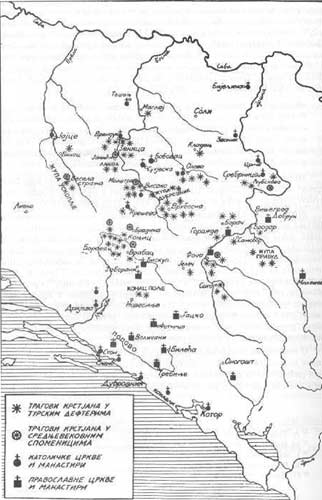
Locations
of churches in Bosnia before the arrival of the Ottomans
(S. Cirkovic "Istorija srednjovjekovne bosanske drzave")

The
fall of Bosnia
When Bosnia
fell to the Ottomans in 1463, and the subsequent process of
Islamisation that ensued, was a key historical turning point.
Now a part of the Ottoman Empire, Bosnia still remained a
border region as far as Croatian history was concerned. The
communication between Croatian and Bosnian territories did
not end in 1463. The Ottoman conquests and incursions into
Croatian lands did make communication more difficult, but
in more peaceful times flows of communication increased. The
Croatian social development in Bosnia under the Turks was
only possible through the influence and the discreet activities
of the Franciscans. The "ahdnama" issued by the
Sultan Mohammed II in 1463, allowed the Bosnian Franciscans
a limited scope, but albeit important, within which to conduct
their activities under the Ottoman rule.70 The ethno-cultural
bridge linking Croats in Bosnia to their brethren in Croatia
was thus not severed, even during the most difficult period
of history.
 |
